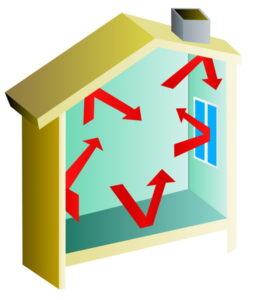
Fresh air is good. We all know this because we were told this since we were children. But it’s harder to get fresh air into a house today than it used to be. Modern homes are built “tight” to increase energy efficiency: less heat gained in hot weather, less heat lost in cold weather. But this tightness traps air indoors and keeps out a fresh breeze that can sweep away the stale, sometimes muggy indoor air.
If you want fresh air in your house, what can you do? Opening the windows is the obvious way—but right now it’s winter. You don’t want to let the chill outdoor temperatures into the house, which will force the heater to work longer to warm the rooms up again.
So are you simply stuck during the winter with a closed-up house? No, there’s a workaround. Actually, an installation. It’s called an energy recovery ventilator and it can make a huge difference for your indoor air quality and energy savings.
Use the Heat in Your Home to Heat the Incoming Air
That is the simplest explanation for how an energy recovery ventilator (or ERV) works. You’ve already paid to heat the air in your home using a furnace or heat pump. Rather than having that heat just escape to the outside through an open window, an ERV uses the heat to warm a current of fresh air vented from outside. This “recovers” the heat, rather than loses it, and applies it to the fresh air. The stale indoor air is vented outside, and the fresh air is sent indoors, already pre-heated so the HVAC system won’t have to overwork to compensate.
The pre-heating occurs inside the ERV itself, where the two air currents—warm indoor air and cold outdoor air—pass by each other. Through a process called counterflow heat exchange, the heat from the indoor air transfers to the outdoor air, naturally heating it. On average, an ERV can recover 80% of the heat from indoors and use it on the incoming air.
There’s a bonus effect as well: moisture moves between the two air currents, helping to create balanced indoor humidity.
It Works for Summer as Well
An ERV is an indoor air quality device for all seasons. When the summer arrives and you’re faced with the problem of trying to enjoy fresh air without letting in humid and hot outdoor temperatures, an energy recovery ventilator can help. It simply works in reverse. Cool indoor air passes through warm outdoor air, and the outdoor air loses its heat and cools down before it gets to the house. The outdoor air will also lose its humidity to the drier indoor air.
We have several indoor air quality services for Conyers, GA homes that can help you enjoy fresher air. Along with energy recovery ventilators, we also install heat recovery ventilators, which work in a similar fashion but don’t transfer moisture and tend to work better in colder temperatures. We can help you determine which of the two is best for your home.
Premier Heating & Air serves South Metro Atlanta and has been family-owned and operated since 2001. Experience the Premier Difference!

